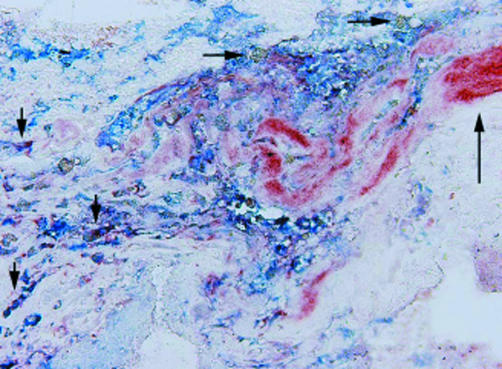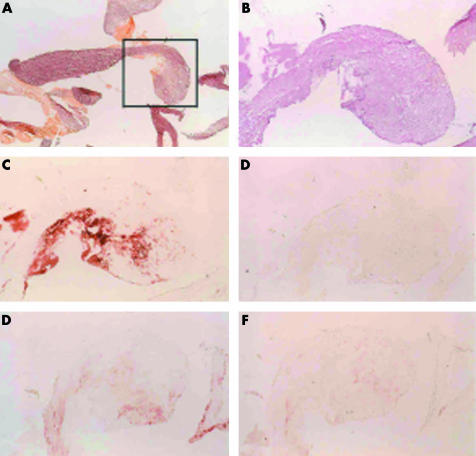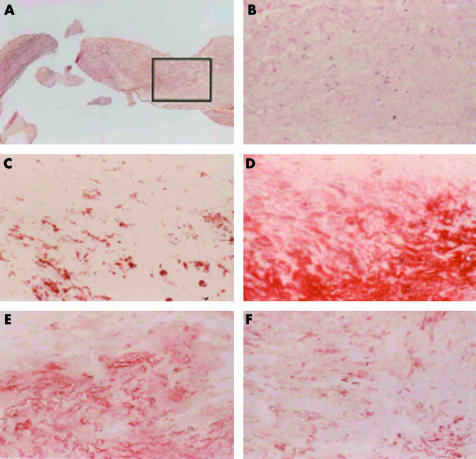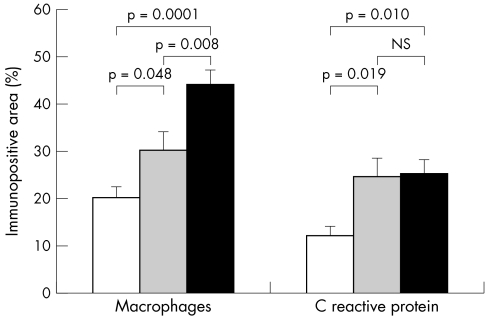Abstract
Background
C reactive protein (CRP), an important serum marker of atherosclerotic vascular disease, has recently been reported to be active inside human atherosclerotic plaques.
Aims
To investigate the simultaneous presence of macrophages, CRP, membrane attack complex C5b–9 (MAC), and oxidised low density lipoprotein (oxLDL) in atherectomy specimens from patients with different coronary syndromes.
Methods
In total, 54 patients with stable angina (SA; n = 21), unstable angina (UA; n = 15), and myocardial infarction (MI; n = 18) underwent directional coronary atherectomy for coronary lesions. Cryostat sections of atherosclerotic plaques were immunohistochemically stained with monoclonal antibodies: anti‐CD68 (macrophages), anti‐5G4 (CRP), aE11 (MAC), and 12E7 (oxLDL). Immunopositive areas were evaluated in relation to fibrous and neointima tissues, atheroma, and media. Quantitative analysis was performed using image cytometry with systematic random sampling (percentage immunopositive/total tissue area).
Results
Macrophages, CRP, MAC, and oxLDL were simultaneously present in a higher proportion of fibrous tissue and atheroma of atherectomy specimens from patients with UA and MI compared with SA (p<0.05). Quantitative analysis showed significantly higher mean percentages of macrophages in plaques from patients with MI (44%) than UA (30%; p<0.01) and SA (20%; p<0.001). Significantly higher mean percentages of CRP were also seen in MI (25%) and UA (25%) compared with SA (12%; p<0.05).
Conclusions
The presence of CRP, complement, and oxLDL in a high proportion of plaque tissue from patients with unstable coronary artery disease implies that these surrogate markers have important proinflammatory effects inside atherosclerotic plaques. This may increase vulnerability to plaque rupture and thrombosis, with subsequent clinical sequelae.
Keywords: acute coronary syndromes, atherosclerosis, plaque inflammation, C reactive protein
Immune mechanisms are thought to play a pivotal role in atherosclerosis,1,2 and inflammatory mediators are thought to be instrumental in early atherosclerotic lesion formation, plaque progression, and plaque rupture.3 Moreover, inflammatory markers, such as C reactive protein (CRP), are strong independent predictors of future cardiovascular risk.1
“C reactive protein could be involved directly in the intraplaque inflammatory process by stimulating monocytes to release inflammatory cytokines, and by inducing adhesion molecule expression in the endothelium”
Recently, CRP was identified within early atherosclerotic lesions in human coronary arteries obtained at necropsy.2 This is of interest, because CRP could be involved directly in the intraplaque inflammatory process by stimulating monocytes to release inflammatory cytokines,3 and by inducing adhesion molecule expression in the endothelium.4 Furthermore, CRP promotes foam cell formation by opsonising low density lipoprotein (LDL).5 Recently, Ehara et al showed that more severe lesions also contain a significantly higher proportion of oxidised LDL (oxLDL) positive macrophages.6 CRP may induce complement activation via the classical pathway,7 which may lead to further progression and destabilisation of atherosclerotic plaques. However, limited data are available on the role of plaque CRP content and the clinical manifestation of coronary syndromes. Therefore, the aim of our present study was to evaluate the extent of anti‐CRP immunostaining in plaque tissue obtained by directional coronary atherectomy from patients with stable angina (SA), unstable angina (UA), and acute myocardial infarction (MI). Furthermore, we studied the simultaneous presence of immunostaining for macrophages, complement (C5b–9; membrane attack complex; MAC), and oxLDL in serial sections of atherectomy tissues from all patients, to determine whether or not tissue CRP is active in a proinflammatory plaque microenvironment. For this purpose, patients were grouped according to the clinical severity of the coronary syndromes and the immunostaining results were compared between the different patient groups.
Methods
Patients
In total, 54 patients with SA8 (Canadian Cardiovascular Society class 1–3; n = 21), UA9 (Braunwald's class II and III; n = 15), and acute MI (defined by 30 minutes rest angina with electrocardiographic signs of transmural anteroseptal and/or inferior infarction with involvement of the right ventricle or the posterolateral wall of the left ventricle; n = 18) underwent directional coronary atherectomy for de novo culprit coronary lesions. The coronary lesion was identified as the “culprit lesion” in UA based on clinical, electrocardiographic, and angiographic findings. In addition, the identification of the culprit lesion in patients with SA included the results of exercise testing. The institutional ethics committee approved our study protocol. All patients gave informed consent.
Quantitative assessment of coronary stenosis
Quantitative coronary stenosis assessment was performed according to routine procedures, as described previously.10
Immunohistochemistry
The coronary plaque specimens were directly frozen in liquid nitrogen and stored at −80°C. All specimens were serially sectioned at 5 μm thickness and prepared for immunohistochemistry. The primary monoclonal antibodies used were anti‐CD68 (Dakopatts, Glostrup, Denmark) for macrophages; anti‐5G4 for CRP, which was obtained by fusing spleen cells from a mouse immunised with human CRP with SP2/0 cells, as described by Wolbink and colleagues7; aE1 (Dakopatts) for C5b‐9; and 12E7 (Biodesign International, Saco, Maine, USA) for oxLDL.11 In all cases, a three step indirect peroxidase method was used, as described previously,12 and antibody complexes were visualised by 3‐amino‐ethylcarbazole. The tissue distribution of CRP was further evaluated by means of double immunostaining with unlabelled anti‐5G4 (CRP) and biotinylated anti‐CD68 (macrophages) in the same tissue section. We used a multistep double staining procedure with an animal research kit, as described previously.13 Positive control and non‐immune negative control slides were performed for each stain. As a positive control for anti‐5G4 (CRP) staining we used fresh frozen tissue obtained from human hearts with acute MI.14 Control experiments were performed by substituting the primary antibody with an irrelevant antibody of similar isotype.
Qualitative and quantitative morphology
Qualitative assessment was performed by determining the immunopositive areas, and if possible, in relation to fibrous, neointima, atheroma, and media tissues. Haematoxylin and eosin and elastic van Gieson stained sections were used to identify15 the following: (1) fibrous tissue, characterised by fibrocellular or fibrosclerotic tissue with sparse cells or by hypercellular areas without evidence of stellate cells; (2) neointima tissue, defined by hypercellular myxoid tissue with stellate shaped cells; (3) atheroma tissue, characterised by necrotic cellular debris, with or without cholesterol crystals and without connective tissue; and (4) media tissue, conclusively based on fragments that contained part of the internal elastic lamina. The simultaneous presence of CD68, 5G4, aE11, and 12E7 was assessed in specimens from patients with SA, UA, and MI in relation to fibrous cap tissue, neointima tissue, atheroma, and media. Two observers independently performed the classification of the plaques. A third review followed in cases of disagreement (< 5% of cases) and a consensus was reached. The observers were blinded to the results of the clinical findings.16
Quantitative analysis of immunohistochemistry was performed by means of image cytometry (QPRODIT 5.2),17 with systematic random sampling. For each specimen, the total plaque area was outlined manually and the areas stained with anti‐CD68 and anti‐5G4, respectively, were calculated automatically. Results were expressed as percentage immunopositive tissue area of the total tissue area.
Statistical analysis
Data are expressed as mean (SEM). One way ANOVA and a post hoc Scheffe's test (SPSS, version 12.0; SPSS, Arlington, Virginia, USA) were used for comparison of continuous data within the three patient subgroups. A χ2 test was performed for categorical data. Values of p < 0.05 were considered significant.
Results
Patients
Table 1 summarises the baseline characteristics of the study patients.
Table 1 Baseline characteristics of all study patients.
| All groups | SA (n = 21) | UA (n = 15) | MI (n = 18) | |
|---|---|---|---|---|
| Mean (SD) age (years) | 58.8 (2.3) | 58.6 (3.3 | 59.7 (3.0 | |
| Male | ||||
| Yes | n = 44 | 17 (39%) | 13 (30%) | 14 (32%) |
| No | n = 10 | 4 (40%) | 2 (20%) | 4 (40%) |
| Hypertension | ||||
| Yes | n = 14 | 3 (21%) | 5 (36%) | 6 (43%)) |
| No | n = 38 | 18 (47%) | 10 (26%) | 12 (32%) |
| Hypercholesterolaemia | ||||
| Yes | n = 16 | 6 (38%) | 3 (19%) | 7 (44%) |
| No | n = 38 | 15 (39%) | 12 (32%) | 11 (29%) |
| Family history | ||||
| Yes | n = 17 | 5 (29%) | 5 (29%) | 7 (41%) |
| No | n = 37 | 16 (43%) | 10 (27%) | 11 (30%) |
| Cigarette smoking | ||||
| Yes | n = 25 | 8 (32%) | 11 (44%) | 6 (24%) |
| No | n = 29 | 13 (45%) | 4 (14%) | 12 (41%) |
| Nitrate | ||||
| Yes | n = 32 | 19* (59%) | 10* (31%) | 3 (9%) |
| No | n = 22 | 2* (9%) | 5 (23%) | 15 (69%) |
| β Blocker | ||||
| Yes | n = 32 | 17* (53%) | 12* (38%) | 3 (9%) |
| No | n = 22 | 4 (18%) | 3* (14%) | 15 (69%) |
| Calcium antagonist | ||||
| Yes | n = 32 | 18* (56%) | 13* (41%) | 1 (3%) |
| No | n = 22 | 3* (14%) | 2* (9%) | 17 (77%) |
| Aspirin | ||||
| Yes | n = 42 | 19* (45%) | 13* (31%) | 10 (24%) |
| No | n = 12 | 2* (17%) | 2* (17%) | 8 (67%) |
| Statin | ||||
| Yes | n = 5 | 1 (20%) | 2 (40%) | 40% (2) |
| No | n = 49 | 20 (41%) | 13 (27%) | 16 (33%) |
| ACE inhibitors | ||||
| Yes | n = 7 | 3 (43%) | 2 (29%) | 2 (29%) |
| No | n = 47 | 18 (38%) | 28% (13) | 16 (34%) |
| Mean (SD) diameter stenosis (%) | 67.7 (11.7) | 71.4 (9.2)*† | 99.9 (0.2)† | |
| Mean (SD) reference diameter (mm) | 3.60 (0.73) | 3.77 (0.43) | 3.66 (0.63) | |
| Mean (SD) time interval between symptoms and atherectomy (days) | 130 (23) | 10.0 (2.86)*† | 0.13 (0.015)† |
Coronary risk factors were defined as described previously.18
*p<0.05 compared with MI group; †p<0.001 compared with SA group.
ACE, angiotensin converting enzyme; MI, myocardial infarction; SA, stable angina pectoris; UA, unstable angina pectoris.
Immunohistochemistry
Immunohistochemistry was performed on atherectomy specimens from all patients; serial staining results for macrophages, CRP, MAC, and oxLDL were available in 54, 48, 54, and 48 patients, respectively. Serial sections with all four sets of staining results were available for 45 patients. Immunohistochemical analysis showed distinct multifocal presence of CRP (fig 1), predominantly in the fibrocellular and atheroma tissue (table 2). Most staining for CRP was seen in the cytoplasm of macrophages and in the extracellular space (fig 2). Staining in fibrous, neointima, and atheroma tissues showed that there was a close relation between the presence of macrophages, CRP, MAC, and oxLDL (tables 2, 3). The simultaneous presence of macrophages, CRP, MAC, and oxLDL was seen significantly more frequently in fibrous tissue and atheroma specimens from patients with UA and MI compared with SA (table 3). Figures 3 and 4 show immunohistochemical images of atherectomy specimens from patients with SA and MI, respectively.
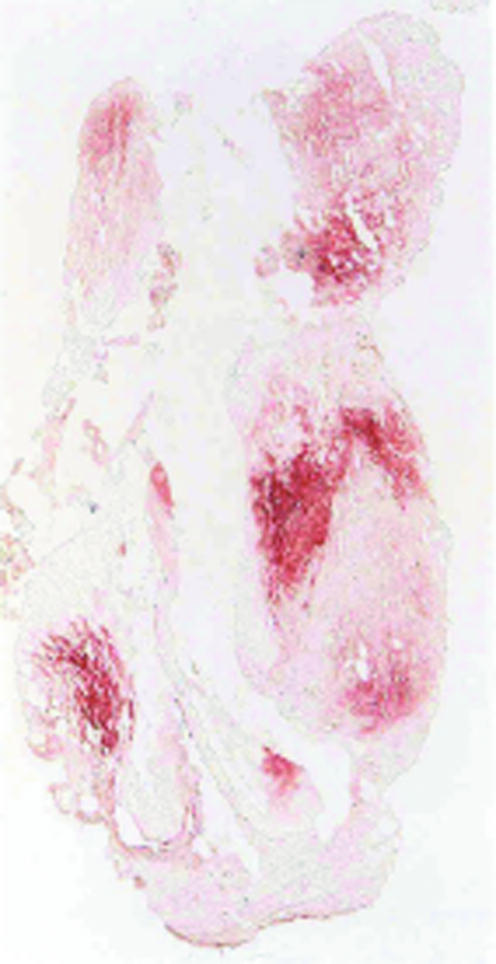
Figure 1 Part of an atherectomy specimen of a culprit lesion from a patient with unstable angina showing distinct multifocal presence of C reactive protein (anti‐5G4).
Table 2 Number of specimens positive for macrophages, CRP, MAC, and oxLDL in relation to the different plaque components.
| Macrophages (n = 54) | CRP (n = 48) | MAC (n = 54) | oxLDL (n = 48) | |
|---|---|---|---|---|
| Fibrous tissue | 53/54* | 44/54 | 47/48* | 47/48* |
| Neointima | 25/31† | 12/29† | 22/25 | 22/25 |
| Atheroma | 49/50*‡ | 38/50‡ | 37/44† | 39/42* |
| Media | 4/14†‡ | 5/8 | 6/10† | 4/10†‡ |
*p<0.05 compared with media; †p<0.05 compared with fibrocellular tissue; ‡p<0.05 compared with neointima.
CRP, C reactive protein; MAC, membrane attack complex; oxLDL, oxidised low density lipoprotein.
Figure 2 Detail of atherectomy specimen double stained with anti‐5G4 (C reactive protein (CRP), red stain) and anti‐CD68 (macrophages, blue stain) showing extracellular localisation of CRP (long vertical arrow) and intracellular localisation in macrophages (short vertical arrows). Ceroid pigment, an end product of lipid peroxidation (horizontal arrows), can also be seen in this area of the atherectomy tissue.
Table 3 Simultaneous presence of macrophages, CRP, MAC, and oxLDL in atherectomy specimens of culprit lesions from patients with SA, UA, and MI in relation to the different plaque components.
| SA (n = 16) | UA (n = 13) | MI (n = 16) | |
|---|---|---|---|
| Fibrous tissue | 9/16*† | 12/13 | 15/16 |
| Neointima | 0/9* | 3/8 | 6/7 |
| Atheroma | 5/16* | 9/12 | 16/16 |
| Media | 0/6 | 0/1 | 2/3 |
*p<0.05 compared with MI; †p<0.05 compared with UA.
CRP, C reactive protein; MAC, membrane attack complex; MI, myocardial infarction; oxLDL, oxidised low density lipoprotein; SA, stable angina; UA, unstable angina.
Figure 3 Serial sections of an atherectomy specimen from the coronary lesion of a patient with stable angina. (A) Overview; elastic van Gieson stain; the boxed area is shown in (B) to (F). (B) Haematoxylin and eosin stained section showing part of a fibrous cap and scarcity of inflammatory cells. (C–F) Immunostaining showing (C) macrophages (anti‐CD68), (D) lack of staining for C reactive protein (5G4), (E) membrane attack complex C5b–9 (aE11), and (F) oxidised low density lipoprotein (anti‐12E7).
Figure 4 Serial sections of an atherectomy specimen from a coronary lesion of a patient with acute myocardial infarction. (A) Overview; elastic van Gieson stain; the boxed area is shown in (B) to (F). (B) Haematoxylin and eosin stained section of part of the fibrous cap containing inflammatory cells. (C–F) Immunostaining showing (C) macrophages (anti‐CD68), (D) C reactive protein (anti‐5G4), (E) membrane attack complex C5b–9 (aE11), and (F) oxidised low density lipoprotein (12E7).
Quantitative morphology
Quantification of immunostaining showed a significant positive relation between the number of macrophages and the severity of the coronary syndrome (fig 5). Furthermore, CRP immunostaining was significantly higher in MI and UA compared with SA (fig 5).
Figure 5 Quantitative immunohistochemical data relating to relative amounts of macrophages (mean, SEM) and C reactive protein in coronary lesions from patients with stable angina (open bars), unstable angina (grey bars), and acute myocardial infarction (black bars).
Discussion
We demonstrate a positive relation between the extent of intraplaque CRP immunostaining and the clinical severity (instability) of coronary atherosclerotic disease. The clinical presentation of coronary syndromes varies between SA and acute MI. The pronounced prevalence of CRP in unstable lesions, together with other inflammatory markers such as macrophages, complement C5b–9, and oxLDL, implies that CRP contributes to the inflammatory process in acute coronary syndromes. This suggests a pathogenic role for CRP in plaque destabilisation and, hence, in the genesis of acute coronary syndromes.
In the past decade, CRP has been used as an indicator of an “inflammatory condition”. A positive relation between serum concentrations of CRP and the severity of the clinical manifestations of coronary syndromes has been demonstrated.19 Furthermore, high concentrations of CRP were positively associated with the severity of future cardiovascular events, even after coronary intervention.1,20,21 Treatment with anti‐inflammatory agents such as aspirin or statins reduces the risk of cardiovascular events.22,23 Only a limited number of patients were treated with lipid lowering agents at the time of our study, precluding conclusions with regard to the role of lipid lowering medications and plaque inflammation. In addition, other factors such as extravascular infections, tissue injury, smoking, and obesity increase plasma concentrations of CRP via other cytokines, mainly interleukin 6.24,25 CRP was initially assumed to be produced solely by the liver. The production of acute phase proteins is upregulated in hepatocytes through cytokines in response to tissue injury, including MI.26 Apart from this systemic response to inflammation, it has now been shown that cells within atherosclerotic plaques also synthesise CRP.27,28,29 Macrophages and smooth muscle‐like cells in atherosclerotic plaques produce seven times more CRP mRNA than the liver.27 Whether or not this “plaque CRP” contributes to the concentration of measured blood CRP and vice versa is unknown, and was not investigated in our study, because serum CRP values were not measured at the time that our study was initiated. Furthermore, we did not investigate the effects of smooth muscle cells on CRP. The idea that CRP can be instrumental in orchestrating intraplaque inflammation stems from the fact that CRP has a profound effect on immune mechanisms known to play a role in atherogenesis. For instance, CRP can be chemotactic for monocytes and lymphocytes by inducing adhesion molecule expression on the endothelium.4 Monocytes, after migration into the atherosclerotic plaque, transform into macrophages and, subsequently, into foam cells by phagocytosis of oxLDL,30,31 a phenomenon that can be stimulated by CRP.5 The inflammatory cascade is further stimulated by the chemotactic response of other monocytes to oxLDL and binding of CRP to enzymatically modified LDL, thus activating complement.32,33 CRP may also activate complement via the classical pathway.2,7 However, the potential proinflammatory role of CRP by the activation of complement is debatable. Data from Mold et al indicate that CRP decreases the activation of the alternative pathway of complement.34 It is intriguing, therefore, that CRP in human atherosclerotic lesions localises in close association with macrophages, the terminal MAC of human complement, and oxLDL. It has been reported previously that in early lesions, diffuse deposition of CRP occurs in the deep fibroelastic and muscular layer of the intima and in foam cell macrophages in the subendothelial layer, although there is no complement colocalisation at this second site.2 We found colocalisation between CRP, macrophages, MAC, and oxLDL in a high proportion of samples, in particular in atheroma and fibrous tissue. However, this observation contrasts with the study of Torzewski et al.2 This could be explained by differences in the stage of the atherosclerotic lesions studied. Our study was performed on advanced and complicated lesions from patients with acute coronary syndromes, whereas Torzewski et al studied early lesions or “fatty streaks”.2 In our present study, which was focused on tissue derived from advanced symptomatic plaques, CRP and oxLDL were found in all the histologically different tissue components of the plaque, although expression was lowest in “young” neointimal tissue. Yasojima et al reported a similar colocalisation of CRP and macrophages in advanced human atherosclerotic plaques obtained at necropsy.27 Recently, Burke and colleagues35 reported that high concentrations of plasma CRP in victims of sudden coronary death were associated with intraplaque CRP staining intensity.
“C reactive protein and oxidised low density lipoprotein were found in all the histologically different tissue components of the plaque, although expression was lowest in young neointimal tissue”
Our study had several limitations. The use of coronary atherectomy specimens bears the risk of inducing sampling bias, particularly in small sample studies. The atherectomy specimen may provide tissue from an unknown site of the coronary lesion and only a part of the entire plaque is excised. Furthermore, variation within plaques would be difficult to evaluate because only two sections were analysed for each patient for each antibody. Despite this, the use of directional coronary atherectomy specimens is a unique way to study correlations between the histopathology of coronary lesions and clinical syndromes.
Numerous studies have shown that the degree of (plaque) inflammation is an important indicator for the incidence of future adverse cardiac events, even after coronary intervention.23,36 This suggests a “smouldering” inflammatory process responsible for recurrent destabilisation, despite debulking, of coronary plaques.36,37 Serum CRP was recently used to guide medical treatment aimed at reducing inflammation and altering subsequent clinical events.38 Consequently, reducing inflammation, which affects the entire coronary tree, seems to be more essential than debulking of atheroma.
Take home messages
C reactive protein (CRP), complement, and oxidised low density lipoprotein were present in a high proportion of plaque tissue from patients with unstable coronary artery disease
These surrogate markers probably have important proinflammatory effects inside atherosclerotic plaques
Thus, CRP seems to contribute to the lipid driven inflammatory process within atherosclerotic plaques of patients with unstable coronary syndromes and probably plays a mechanistic role in the onset of plaque instability, rather than being merely a serum marker for cardiovascular disease
These findings support the hypothesis that the self amplifying inflammatory response accounts for the severity of the coronary syndrome
In conclusion, our data imply that CRP contributes to the lipid (oxLDL) driven inflammatory process within atherosclerotic plaques of patients with unstable coronary syndromes and, hence, may play a mechanistic role in the onset of plaque instability, rather than being merely a serum marker for cardiovascular disease. These findings support the hypothesis that the self amplifying inflammatory response accounts for the severity of the coronary syndrome. This concept is supported by our observation that macrophages, CRP, MAC, and oxLDL show a high incidence of colocalisation, in particular in patients with acute MI.
Abbreviations
CRP - C reactive protein
MAC - membrane attack complex
MI - myocardial infarction
oxLDL - oxidised low density lipoprotein
SA - stable angina
UA - unstable angina
References
- 1.Ridker P M. High‐sensitivity C‐reactive protein: potential adjunct for global risk assessment in the primary prevention of cardiovascular disease. Circulation 20011031813–1818. [DOI] [PubMed] [Google Scholar]
- 2.Torzewski J, Torzewski M, Bowyer D E.et al C‐reactive protein frequently colocalizes with the terminal complement complex in the intima of early atherosclerotic lesions of human coronary arteries. Arterioscler Thromb Vasc Biol 1998181386–1392. [DOI] [PubMed] [Google Scholar]
- 3.Ballou S P, Lozanski G. Induction of inflammatory cytokine release from cultured human monocytes by C‐reactive protein. Cytokine 19924361–368. [DOI] [PubMed] [Google Scholar]
- 4.Pasceri V, Willerson J T, Yeh E T H. Direct proinflammatory effect of C‐reactive protein on human endothelial cells. Circulation 20001022165–2168. [DOI] [PubMed] [Google Scholar]
- 5.Zwaka T P, Hombach V, Torzewski J. C‐reactive protein‐mediated low density lipoprotein uptake by macrophages: implications for atherosclerosis. Circulation 20011031194–1197. [DOI] [PubMed] [Google Scholar]
- 6.Ehara S, Ueda M, Naruko T.et al Elevated levels of oxidized low density lipoprotein show a positive relationship with the severity of acute coronary syndromes. Circulation 20011031955–1960. [DOI] [PubMed] [Google Scholar]
- 7.Wolbink G, Brouwer M, Buysmann S.et al CRP‐mediated activation of complement in vivo: assessment by measuring circulating complement–C‐reactive protein complexes. J Immunol 1996157473–479. [PubMed] [Google Scholar]
- 8.Campeau L. Grading of angina pectoris [letter]. Circulation 197654522–523. [PubMed] [Google Scholar]
- 9.Braunwald E. Unstable angina. A classification. Circulation 198980410–414. [DOI] [PubMed] [Google Scholar]
- 10.Meuwissen M, Chamuleau S A J, Siebes M.et al Hyperemic coronary stenosis resistance better identifies functionally significant lesions than physiological indexes based on intracoronary pressure or flow velocity alone. Circulation 2000102(suppl II)3096 [Google Scholar]
- 11.Trakht I N, Kovaleva K A, Janushevskaya E V.et al Investigation of human blood plasma Apo B‐containing lipoproteins by means of monoclonal antibodies against low density lipoproteins. Atherosclerosis Reviews 19881751–66. [Google Scholar]
- 12.van der Loos C M, Das P K, Van den Oord J J.et al Multiple immunoenzyme staining techniques. Use of fluoresceinated, biotinylated and unlabelled monoclonal antibodies. J Immunol Methods 198911745–52. [DOI] [PubMed] [Google Scholar]
- 13.van der Loos C M, Gobel H. The animal research kit (ARK) can be used in a multistep double staining method for human tissue specimens. J Histochem Cytochem 2000481431–1438. [DOI] [PubMed] [Google Scholar]
- 14.Lagrand W K, Niessen H W M, Wolbink G‐J.et al C‐reactive protein colocalizes with complement in human hearts during acute myocardial infarction. Circulation 19979597–103. [DOI] [PubMed] [Google Scholar]
- 15.Moreno P R, Bernardi V H, Lopez‐Cuellar J.et al Macrophages, smooth muscle cells, and tissue factor in unstable angina. Implications for cell‐mediated thrombogenicity in acute coronary syndromes. Circulation 1996943090–3097. [DOI] [PubMed] [Google Scholar]
- 16.van der Wal A C, Becker A E, Koch K T.et al Clinically stable angina pectoris is not necessarily associated with histologically stable atherosclerotic plaques. Heart 199676312–316. [DOI] [PMC free article] [PubMed] [Google Scholar]
- 17.Polkowski W, Meijer G A, Baak J P.et al Reproducibility of p53 and Ki‐67 immunoquantitation in Barrett's esophagus. Anal Quant Cytol Histol 199719246–254. [PubMed] [Google Scholar]
- 18.Meuwissen M, van der Wal A C, Koch K.et al Complex coronary artery stenosis and unstable angina are positively associated with the extent of plaque inflammation. Am J Med 2003114521–527. [DOI] [PubMed] [Google Scholar]
- 19.Berk B C, Weintraub W S, Alexander R W. Elevation of C‐reactive protein in “active” coronary artery disease. Am J Cardiol 199065168–172. [DOI] [PubMed] [Google Scholar]
- 20.Biasucci L M, Liuzzo G, Grillo R L.et al Elevated levels of C‐reactive protein at discharge in patients with unstable angina predict recurrent instability. Circulation 199999855–860. [DOI] [PubMed] [Google Scholar]
- 21.Liuzzo G, Biasucci L M, Gallimore J R.et al The prognostic value of C‐reactive protein and serum amyloid A protein in severe unstable angina. N Engl J Med 1994331417–424. [DOI] [PubMed] [Google Scholar]
- 22.Ridker P M, Cushman M, Stampfer M J.et al Inflammation, aspirin, and the risk of cardiovascular disease in apparently healthy men. N Engl J Med 1997336973–979. [DOI] [PubMed] [Google Scholar]
- 23.Libby P, Ridker P M, Maseri A. Inflammation and atherosclerosis. Circulation 20021051135–1143. [DOI] [PubMed] [Google Scholar]
- 24.Munford R S. Statins and the acute‐phase response. N Engl J Med 20013442016–2018. [DOI] [PubMed] [Google Scholar]
- 25.Lagrand W K, Visser C A, Hermens W T.et al C‐reactive protein as a cardiovascular risk factor: more than an epiphenomenon? Circulation 199910096–102. [DOI] [PubMed] [Google Scholar]
- 26.Gabay C, Kushner I. Acute‐phase proteins and other systemic responses to inflammation. N Engl J Med 1999340448–454. [DOI] [PubMed] [Google Scholar]
- 27.Yasojima K, Schwab C, McGeer E G.et al Generation of C‐reactive protein and complement components in atherosclerotic plaques. Am J Pathol 20011581039–1051. [DOI] [PMC free article] [PubMed] [Google Scholar]
- 28.Calabro P, Willerson J T, Yeh E T H. Inflammatory cytokines stimulated C‐reactive protein production by human coronary artery smooth muscle cells. Circulation 20031081930–1932. [DOI] [PubMed] [Google Scholar]
- 29.Jabs W J, Theissing E, Nitschke M.et al Local generation of C‐reactive protein in diseased coronary artery venous bypass grafts and normal vascular tissue. Circulation 20031081428–1431. [DOI] [PubMed] [Google Scholar]
- 30.Ross R. Atherosclerosis—an inflammatory disease. N Engl J Med 1999340115–126. [DOI] [PubMed] [Google Scholar]
- 31.Steinberg D, Parthasarathy S, Carew T E.et al Beyond cholesterol. Modifications of low‐density lipoprotein that increase its atherogenicity. N Engl J Med 1989320915–924. [DOI] [PubMed] [Google Scholar]
- 32.Quinn M T, Parthasarathy S, Fong L G.et al Oxidatively modified low density lipoproteins: a potential role in recruitment and retention of monocyte/macrophages during atherogenesis. Proc Natl Acad Sci U S A 1987842995–2998. [DOI] [PMC free article] [PubMed] [Google Scholar]
- 33.Bhakdi S, Torzewski M, Klouche M.et al Complement and atherogenesis: binding of CRP to degraded, nonoxidized LDL enhances complement activation. Arterioscler Thromb Vasc Biol 1999192348–2354. [DOI] [PubMed] [Google Scholar]
- 34.Mold C, Gewurz H, Du Clos T W. Regulation of complement activation by C‐reactive protein. Immunopharmacology 19994223–30. [DOI] [PubMed] [Google Scholar]
- 35.Burke A P, Tracy R P, Kolodgie F.et al Elevated C‐reactive protein values and atherosclerosis in sudden coronary death: association with different pathologies. Circulation 20021052019–2023. [DOI] [PubMed] [Google Scholar]
- 36.Piek J J, van der Wal A C, Meuwissen M.et al Plaque inflammation in restenotic coronary lesions of patients with stable or unstable angina. J Am Coll Cardiol 200035963–967. [DOI] [PubMed] [Google Scholar]
- 37.Meuwissen M, Piek J J, van der Wal A C.et al Recurrent unstable angina after directional coronary atherectomy is related to the extent of initial coronary plaque inflammation. J Am Coll Cardiol 2001371271–1276. [DOI] [PubMed] [Google Scholar]
- 38.Ridker P M, Rifai N, Clearfield M.et al Measurement of C‐reactive protein for the targeting of statin therapy in the primary prevention of acute coronary events. N Engl J Med 20013441959–1965. [DOI] [PubMed] [Google Scholar]



